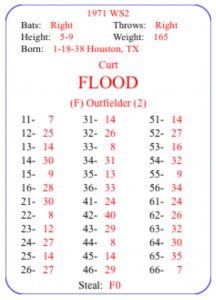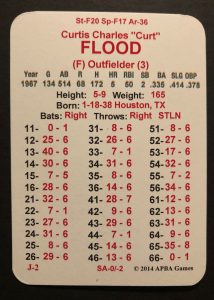
Nearly fifty years ago, Curt Flood changed the landscape of professional sports when he challenged baseball’s reserve clause. On Christmas Eve, 1969, Flood wrote to Commissioner Bowie Kuhn, “After 12 years in the major leagues. I do not feel that I am a piece of property to be bought and sold irrespective of my wishes.” Unfortunately for Flood, it was the beginning of the end of a fifteen year Major League career.
In the end, Flood was blackballed from baseball and sacrificed his career for the betterment of future baseball players and other professional athletes. Though he lost his court case in 1972, Flood paved the way for free agency in the mid-1970s after Andy Messersmith and Dave McNally played without contracts. His sacrifice also led to the 10/5 rule or Curt Flood Rule, which states that when a player has ten years of MLB service and five consecutive years for the same ball club, he has to give his consent to be traded.
Curt Flood was a three-time, All-Star centerfielder who broke in with the Cincinnati Reds in 1956 when he was 18 years old. In two seasons with the Reds, the younger outfielder only played in ten games before he was traded to the St. Louis Cardinals after the 1957 season. With the Cardinals, Flood was a key part of three World Series teams, and he helped St. Louis win two championships.
By 1969, Flood had won seven consecutive Gold Glove Awards and had supplanted Willie Mays as the National Leagues best defensive centerfielder. However, Flood was an accomplished offensive force during his playing days. Six times he hit over .300 and was a .293 career hitter. Flood’s best season was 1967 when he hit .335 for the World Champion St. Louis Cardinals.

After being traded to the Philadelphia Phillies following the 1969 season, Flood refused to report and sat out 1970. Daily, he received letters stating how he was ruining baseball. Many of the letters also contained death threats. Eventually, the Phillies traded Flood to the Washington Senators. Flood performance was lacklustre at best, as he only hit .200 in thirteen games. Early in the season, he decided his playing days were over. He was just 33-years old.
Curt Flood’s final APBA represents his sacrifice. After a year away from the game, Flood found it difficult to play the game that had once come easily to him. The only thing this card does well is
| I | Split | G | GS | PA | AB | R | H | 2B | 3B | HR | RBI | SB | CS | BB | SO | BA | OBP | SLG | OPS | TB | GDP |
|---|---|---|---|---|---|---|---|---|---|---|---|---|---|---|---|---|---|---|---|---|---|
| 1971 Totals | 13 | 8 | 40 | 35 | 4 | 7 | 0 | 0 | 0 | 2 | 0 | 1 | 5 | 2 | .200 | .300 | .200 | .500 | 7 | 1 |
In the end, Curt Flood wasn’t a Hall of




Hello To All. I’m new to this site looking for help tracking down AFL 60’s seasons in good shape. Ebays prices are off the charts any ideas.Thanks.
Fine article, as all your posts are. I remember reading about all the ex-major leaguers in attendance at Flood’s funeral in 1997–three! Two were Steve Garvey and Jim Kaat and I don’t remember who the third was. Some time after his playing career ended Flood moved to Denmark and spent the rest of his life painting. He was only 59 when he died. Keep up the good work Kevin.